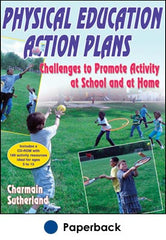Counter myths and stereotypes by providing real life connections
This is an excerpt from Physical Education Action Plans by Charmain Sutherland.
Every activity, suggestion, and lesson in Physical Education Action Plans: Challenges to Promote Activity at School and at Home is presented with a real-life connection so that the physical education experience is rich and relevant for all students from age 5 to 13. The concepts are adapted from the national physical education standards and Concepts and Principles of Physical Education, edited by Bonnie Mohnsen and published by the National Association for Sport and Physical Education (NASPE), a part of AAHPERD, which examines what students should know in grades K through 12, as well as helpful-to-know life concepts. These concepts fall into these categories: biomechanics, motor development, psychology, philosophy, sociology, exercise physiology, kinesiology, historical perspective, motor learning, and aesthetics.
Our coworkers, bosses, and the public have a vision of what our job as physical educators is, but few really understand the importance of physical education. Here are a few myths and stereotypes to overcome:
- Myth 1: Physical educators train students to become elite athletes. You realize that you are not training everyone to become an Olympic athlete or professional athlete, right? In 20 years at eight schools, I have yet to see one of my students win a gold medal in the Olympics or make a professional football or basketball team. I would love to see it, and of course it is possible, but it is not the reason for teaching physical education. Thank goodness, because if that were the case, probably at least 95 percent of us would be out of a job.
- Myth 2: Physical educators are supervisors of playtime. Sure, some kids want to play just for play's sake, and that's great. Play is fantastic, fun, imaginative, and creative and will help a child develop, but “play” in physical education involves learning through activity. You are teaching children how to learn through structured instructionally designed play, not just supervising children at play without direction.
- Myth 3: The job of physical educators is to wear the students out. Classroom teachers often say, “I hope you're going to wear those students out.” Sure, exercise is great for a break, rejuvenation, and releasing energy, but in physical education these are secondary benefits. The primary purpose of physical education is to understand why and how we work our bodies so that we can improve our physical fitness and health. Students need to understand the benefits of running and playing, such as increased strength, cardiorespiratory endurance, muscular endurance, flexibility, muscle tone, and skill.
- Myth 4: Physical education is one dimensional. Physical education is not just about teaching skills. Rather, it can help a person's life and growth in a variety of ways. Physical education helps build and maintain healthy bones, muscles, and joints. It also helps control weight, build lean muscle, and reduce fat, while helping students become aware of body composition. Awareness and guidance provided in physical education “prevents or delays the development of high blood pressure and helps reduce blood pressure in some adolescents with hypertension,” according to the CDC (1999). Participating in physical education can teach us valuable lessons, such as sharing, strategizing, teamwork, the principles of progression, and so on.
To counter these myths and stereotypes, we need to teach using a method that includes everyone and provides connections to real life, which makes learning practical and more personal. This book and the accompanying CD-ROM will help you provide your students with important reasons to learn and move—and to help them become healthier and hopefully have fun. These are powerful motivators! Because students are motivated in different ways, concept-based learning has more depth and more application. Concept-based learning means basing lessons on specific and general physical education and health concepts and building an applicable purpose for learning about the concept's worth and connection to one's real life. Once you have planted the seed, your students will help it grow by building on it and feeding it with more personal connections and experiences.
The philosophy behind Physical Education Action Plans: Challenges to Promote Activity at School and at Home is based in the idea that all students should be aware of and be able to relate to aspects of their lives during physical education activities. Each chapter focuses on a concept that makes a difference and plays a major part in students' positive physical growth.
Read more from Physical Education Action Plans Challenges to Promote Activity at School and at Home by Charmain Sutherland.
More Excerpts From Physical Education Action Plans

Get the latest insights with regular newsletters, plus periodic product information and special insider offers.
JOIN NOW
Latest Posts
- Authenticity was key to McKinney’s NIL success
- AI—A new tool for sport PR pros
- Essential skills for sport PR practitioners
- Employ these tactics when pitching a story to the media
- How does ergonomic analysis and intervention enhance safety and reduce injury risk?
- Common movement patterns in competitive cycling


